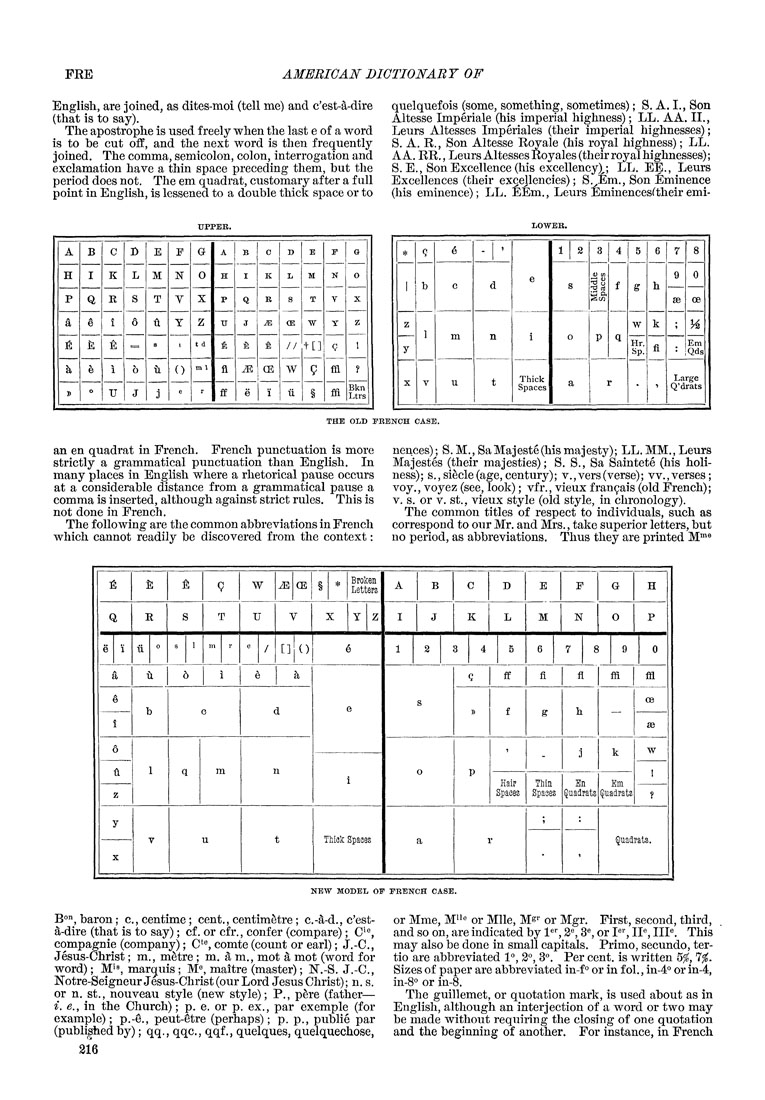FRE
AMERICAN DICTIONARY OF
Enghsh, are joined, as dites-moi (tell me) and c'est-a-dire
(that is to say).
The apostrophe is used freely when the last e of a word
is to be cut off, and the next word is then frequently
joined. The comma, semicolon, colon, interrogation and
exclamation have a thin space preceding them, but the
period does not. The em quadrat, customary after a full
point in English, is lessened to a double thick space or to
quelquefois (some, something, sometimes); S. A. I., Son
Altesse Imperiale (his imperial highness); LL. AA. II.,
Leurs Altesses Imperiales (their imperial highnesses);
S. A. R., Son Altesse Royale (his royal highness); LL.
A A. RR., Leurs Altesses Royales (their royal highnesses);
S.E., Son Excellence (his excellency),; LL. EE., Leurs
Excellences (their excellencies); S.JEm., Son Eminence
(his eminence); LL. EEm,, Leurs EminencesCtheiremi-
A
H
B
I
C
K
D
L
E
M
F
N
G
0
A
B
I
c
K
D
L
E
M
F
N
0
*
<?
6
>
e
1 1 2
3
4
5
6
7
8
H
1
b
c
d
s
P
f
q
g
w
Hr.
Sp.
h
k
fi
9
8B
0
oe
Em
Qds
P
Q
R
S
T
V
X
P
Q
J
R
s
CE
//
T
W
V
Y
<?
X
Z
1
d
§
i
6
ti
Y
Z
IJ
Z
y
X
1
V
m
n
i
o
e
El
i
o
8
tl
0
t d
±
^
B
m \
fl
M
ffi
W
9
ffi
?
u
t
Thick
Spaces
a
r
Large
Q'drats
»
°
U
J
3
e
r
ff
e
i
ti
§
fa
Bkn
Ltrs
THE OLD FRENCH CASE,
an en quadrat in French, French punctuation is more
strictly a grammatical punctuation than English. In
many places in English where a rhetorical pause occurs
at a considerable distance from a grammatical pause a
comma is inserted, although against strict rules. This is
not done in French,
The following are the common abbreviations in French
which cannot readily be discovered from the context:
nences); S. M., SaMajeste(his majesty); LL. MM., Leurs
Majestes (their majesties); S. S., Sa Saintete (his holi¬
ness); s.,siecle (age, century); v., vers (verse); vv., verses;
voy., voyez (see, look); vfr., vieux frangais (old French);
V. s. or V. St., vieux style (old style, in chronology).
The common titles of respect to individuals, such as
correspond to our Mr, and Mrs,, take superior letters, but
no period, as abbreviations. Thus they are printed M'"®
fi
^
fi
9
w
M
CE
§
*
Broken
Letters
A
B
C
D
E
F
G
H
Q
R
S
T
u
V
X
Y
Z
I
J
K
L
M
N
0
P
e
i
ti
0
s
1
,n
r
' /
[] ()
6
1
2
3
4 5
6
7
8
9
0
a
li
O
i
e
a
e
s
?
fe
fi
fl
fli
ffl
e
b
c
d
»
f
g
h
-
06
i
86
6
1
q
m
n
0
P
'
-
.i
k
W
i
ti
1
KaiF
Spaces
Thin
Spaces
En
Quadrats
Em
Quadrats
z
?
y
;
_-----
X
cl
'
NEW MODEL OF FRENCH CASE.
B«", baron; c, centime; cent., centimetre ; c-^-d., c'est-
^-dire (that is to say); cf, or cfr,, confer (compare); C'*^,
compagnie (company); C*% comte (count or earl); J,-C.,
Jesus-Christ; m,, m^tre ; m. ^ m., mot k mot (word for
word); M^% marquis ; M% maitre (master); N.-S. J,-C,,
Notre-Seigneur Jesus-Christ (our Lord Jesus Christ); n. s.
or n, st,, nouveau style (new style); P,, p5re (father—
i. e., in the Church); p, e. or p. ex., par exemple (for
example); p.-^,, peut-^tre (perhaps); p. p., public par
(publi|hed by); qq., qqc, qqf., quelques, quelquechose,
316
or Mme, M"*' or Mile, Ms^" or Mgr, First, second, third,
and so on, are indicated by 1^\ 2% 8% or 1^'', 11% IIP. This
may also be done in small capitals. Prime, secundo, ter-
tio are abbreviated I'', 2'', S''. Per cent, is written 5^, 1%.
Sizes of paper are abbreviated in-f'^ or in fol,, in-4° or in-4,
in-8° or in-8.
The guillemet, or quotation mark, is used about as in
English, although an interjection of a word or two may
be made without requiring the closing of one quotation
and the beginning of another. For instance, in French
|








